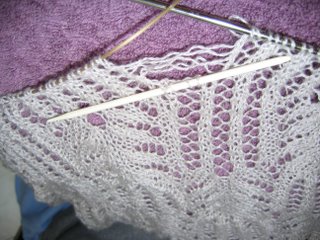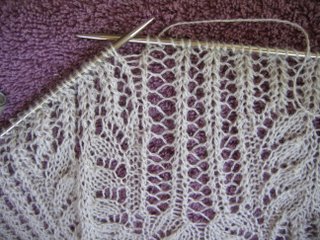 A bit of what I learned while knitting
A bit of what I learned while knitting- Before you start Frost Flowers and Leaves, check that you have the errata for this pattern.
- You can also join a KAL for this shawl, if you like. These knitters mostly began in November 2005, but there have been quite a few recent joiners. The also have a file section for errata, a triangular version, and a spreadsheet on stitch counts. If you like the company, this might be for you.
- I worked myself into a tizzy about needles, thinking I had to have special points for lace. I bought several types - Bryspun, with beautiful tips but really lousy joins, and Baylenes, which were serviceable enough - but not slick enough for me. Well, what I needed was to just get used to manipulating really, really skinny yarn. When I got past the dpn stage, I found that my good old Addi turbos, blunt tips and all, worked just fine.
- I did blow up the chart. No! Not literally! Though I sure felt like it several times during the process of knitting this one. I know they've warned me that they'll throw me in irons for making a photocopy, but I wasn't stealing the pattern. The person at Kinko's did give DH a bad time. But thanks to DH's charm, Kinko's enlarged it, and I got a chart I could actually read. Plus, I don't have to mess up the book.
This stuff makes it simple to mark rows; it stays stick enough to move it a bunch of times, and it's a cinch to read through to the row(s) below.
Circular Cast-on for Frost Flowers and Leaves, and other lace
To start, you'll need to know how to do a circular cast-on. And you'll find that this beginning, with its first few rows, is not so easy to do - no matter how many socks you've already knit on dpn's. You will have eight stitches on four dpn's, and knit friends, it is a pretty good challenge. It gets easier, though - much easier, after a few rounds. Hang in there.
- After making the cast-on ring of stitches, I arrange them on three dpn's using a needle size several sizes smaller than the size I would be using for the shawl. To begin an eight-stitch round, I place 2 stitches on the first needle, 4 on the second, and 2 on the third. I knitted my FF&L with a size four needle, so I began with size 2 dpn's. Now it's easy to see what order the needles need to be in in order to join the first round, and harder to accidentally twist the stitches. I also know, without a marker to further confuse things at this awkward stage, that the beginning of the row is between the two dpn's that have the two stitches on them, so my brain can simply fuss with essential motor skills now. I join and knit the first round.
- At the beginning of the second round, I begin using the next dpn size up, exchanging each needle for the next larger size as I come to it. Each needle still has a unique feature, so it's easy to tell what's next. For example, after knitting one needle in the round, needle 1 is a larger size dpn, needle 2 has more stitches on it, and needle 3 is still the smaller size needle.
- At the beginning of the third round, I begin exchanging each dpn for the next larger size as I did in round 2. By the end of this round, all the dpn's will be the "working" needle size. I work another round or two with 3 needles holding the stitches, and then divide them to the proper 4 dpn's. By this time, things are much more solid on the needles, and I proceed as usual from there.
The difference in stitch size is not really obvious, but those center stitches look beautifully shaped and balanced. Like a lot of knitting instructions, it reads as though it's complicated, but it's really simple when put into action. If this way didn't improve the appearance of the center of the shawl, I would call it a cheat. But even if I could manage all those sticks with utmost grace and finesse during the beginning, I'd still do it my way just for the improved looks.
Casting on Hint 2: Place the work on a pillow, and rotate the pillow, not the dpn's. And use wood (or plastic, but not metal) needles to help reduce the slip.
Casting on Hint 3: If those first yarn-overs at the beginning of the row are making you nuts, skip them and pick them up on the following row.
Casting on hint 4: If you just can't do the circular cast-on, or hate-hate-hate it, do what a couple of my knit pals did: chain eight small stitches, stick 'em on dpn's, join, and go from there.
Getting to the knitty-gritty (sorry)
Gritty hint 1: This pattern got a lot easier for me with each successive chart - especially after the first break in chart one. And remember that you need to move your marker(s) on the arrow rows. The marker is moved at the beginning of each of the corners - knit to marker, remove marker, knit one, replace marker. (See page 3 of the book.)
Gritty hint 2: Learn to correct mistakes in sections, not by frogging or ripping back. Yes you can! Uh-huh, yes you can! Yep, I know, it does look impossible, especially when you're pretty new to lace knitting.. When you're on row 160 and there are 1216 stitches per row, and the mistake is 4 or 9 or 14 rows back, oh, yes you can!
I thought you'd need some kind of knitting high-hooey degree to do this in rather complex knitting, but it isn't so. Here's the trick: Isolate a whole section, if you must, so you can tell exactly where you are through all those yarn-overs and decreases. You gotta know where you are to tell where you're going! Those lattices might drive you nuts if you don't learn how to do this.
There's a mistake in the lattice work below where I've isolated the 4-stitch repeat on a dpn.Get the rest of the stitches out of the way - pull your circulars through to the cord, and use point protectors. The Belt and Suspenders plan is a good one here. (The rest of the lattice is correct, just looks a little wonky in the photo...)
 I frogged back to a row or two above the mistake, and then tinked down below it. I've counted several times to make sure I know which row I'm on.
I frogged back to a row or two above the mistake, and then tinked down below it. I've counted several times to make sure I know which row I'm on.I've marked the chart at my new beginning spot, and am following it meticulously, even though I know it by heart.
Be sure to knit each ladder in order as it appears from right-hand side of the knitting.

Be gentle and take care not to stretch the ladders, using a crochet hook, if necessary. If you have too much ladder, gently work the stitches so that they take up the slack as evenly as you can.
If you have too little ladder, consider omitting any yarn-overs in that row and picking them up on the next row (by scooping them up when it's time to knit them.)
Done.
This probably took fifteen minutes instead of fifteen hours.
To be continued...
(see the completed shawl here)



2 comments:
Why couldn't I have found this before I started my FFL? *augh* LOL
Hi Jessica,
Your post really helped me wrap my head around beginning this pattern, thank you!
I am a little confused still by the move stitch marker. I move it at the beginning of that row, correct?
Also this is my first big (its going to be really big!) lace project and I am not sure how to make sure my gauge will be okay? I feel like my stitches are loose but it's also lace, so I don't know how loose is okay...? any suggestions? I am knitting this to be our Chuppah for our wedding in September.
Thanks so much,
Jessica W.
Post a Comment